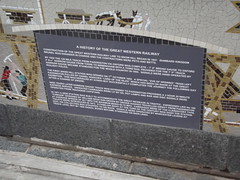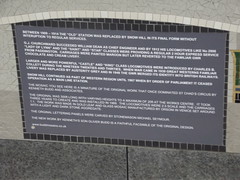Commemorated on 3 plaques
A History of the Great Western Railway Construction of the Great Western Railway line to Snow Hill began in 1847. Isambard Kingdom Brunel was engineer in charge and the contractors were Peto and Betts. By 1852 the 129 mile track from Paddington via Oxford was complete - 7' 0" broad gauge to Oxford 4' 8½" narrow gauge from there to Birmingham with a third rail provided for the 7' 0" track. Narrow gauge became standard for the whole country in 1892. Signals were hand operated by railway police. The first Snow Hill station was opened on 1st October 1852. A special "Eve of Opening" train left Paddington pulled by Daniel Gooches "Lord of the Isles" which had been on show at the Great Exhibition. This was derailed at Aynho but successfully completed the journey the following day after a change in engine. Nine years later narrow gauge track was extended to Paddington providing a 3 hour 20 minute express service. Unheated carriages were lit by oil pot lamps and bar and disc signals were operated from trackside capstans. In 1871 a new station was built to accommodate the great increase in traffic. Expresses like No 162 "Cobham" designed by William Dean and driven by driver Hughes travelled direct from Paddington at average speeds of 52.7 MPH the maximum being 62.75 MPH. Carriages were of the clerestory type. Toilets were introduced in 1873. A familiar sight at the turn of the century was Dash the station dog. His collecting box strapped to his back. Signals were operated by Worcester levers at track level but by 1900 signal boxes became standard on main lines.
Birmingham Snow Hill Station - behind 1 Colmore Row, Birmingham, United Kingdom where it opened (1852)
Between 1909 - 1914 the "old" station was replaced by Snow Hill in its final form without interruption to regular services. G.L. Churchward succeeded William Dean as chief engineer and by 1912 his locomotives like No 2906 "Lady of Lynn" and the "Saint" and "Star" classes were providing a regular 2 hour express service from Paddington. Carriages were painted maroon but later reverted to the familiar GWR chocolate and cream livery. Larger and more powerful "Castle" and "King" class locomotives were introduced by Charles B. Collett during the Nineteen Twenties and Thirties. When war came in 1939 Great Westerns familiar livery was replaced by austerity grey and in 1948 the GWR merged its identity into British Railways. Snow Hill continued as part of Western region until 1967 when by order of Parliament it ceased operation as a main line station. The mosaic you see here is a miniature of the original work that once dominated St Chad's Circus by Kenneth Budd and Associates. The original was 300ft long with varying heights to a maximum of 20ft at the works centre. It took three years to create and was installed in 1969. The locomotives were 2:3 scale and the carriages 1:1. The work was made in gold leaf and glass mosaic manufactured by Orsoni in Venice set around with a light and dark stone aggregate. The original lettering panels were carved by stonemason Michael Seymour. The new work by Kenneth's son Oliver Budd is a faithful facsimile of the original design. www.buddmosaics.co.uk
Birmingham Snow Hill Station - near the Living Wall, Birmingham, United Kingdom where it closed (1967)
In commemoration of the 150th Anniversary of the opening of Birmingham Snow Hill Station Tuesday 1st October 2002 Unveiled by George Windsor, Station Master, Snow Hill 1960-1963 & Rob Donald, Director General, Centro
Snow Hill Railway Station, Birmingham, United Kingdom where it sited
.jpg?width=250)


